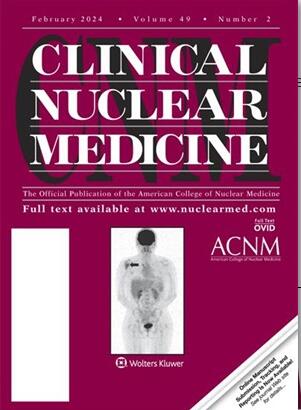18F-FDG PET/CT比68Ga-FAPI PET/CT更早发现直肠恶性肿瘤。
IF 9.6
3区 医学
Q1 RADIOLOGY, NUCLEAR MEDICINE & MEDICAL IMAGING
Clinical Nuclear Medicine
Pub Date : 2025-06-01
Epub Date: 2025-03-05
DOI:10.1097/RLU.0000000000005800
引用次数: 0
摘要
一位69岁的食管癌患者在治疗期间接受了18F-FDG和68Ga-FAPI双示踪PET/CT检查。在基线时,两次扫描均未显示直肠摄取异常。3个月后,中期18F-FDG PET/CT显示直肠局灶性摄取,而68Ga-FAPI PET/CT未见异常。17个月后,他接受了第三次双示踪PET/CT监测。18F-FDG和68Ga-FAPI PET/CT均在直肠同一区域检测到异常活动。术后病理证实为腺癌。我们的病例证明18F-FDG PET/CT比68Ga-FAPI PET/CT更能识别直肠恶性肿瘤。本文章由计算机程序翻译,如有差异,请以英文原文为准。
18 F-FDG PET/CT Identified Rectal Malignancy Earlier Than 68 Ga-FAPI PET/CT.
A 69-year-old man with esophageal cancer underwent dual-tracer PET/CT using 18 F-FDG and 68 Ga-FAPI during his treatment. At baseline, neither scan showed abnormal uptake in the rectum. Three months later, an interim 18 F-FDG PET/CT revealed focal uptake in the rectum, while the 68 Ga-FAPI PET/CT showed no abnormal findings. Seventeen months later, he received a third dual-tracer PET/CT for surveillance. Both 18 F-FDG and 68 Ga-FAPI PET/CT detected abnormal activity in the same area of the rectum . The lesion was later confirmed as adenocarcinoma by histopathology after surgery. Our case demonstrated the 18 F-FDG PET/CT could identify the rectal malignancy before 68 Ga-FAPI PET/CT.
求助全文
通过发布文献求助,成功后即可免费获取论文全文。
去求助
来源期刊

Clinical Nuclear Medicine
医学-核医学
CiteScore
2.90
自引率
31.10%
发文量
1113
审稿时长
2 months
期刊介绍:
Clinical Nuclear Medicine is a comprehensive and current resource for professionals in the field of nuclear medicine. It caters to both generalists and specialists, offering valuable insights on how to effectively apply nuclear medicine techniques in various clinical scenarios. With a focus on timely dissemination of information, this journal covers the latest developments that impact all aspects of the specialty.
Geared towards practitioners, Clinical Nuclear Medicine is the ultimate practice-oriented publication in the field of nuclear imaging. Its informative articles are complemented by numerous illustrations that demonstrate how physicians can seamlessly integrate the knowledge gained into their everyday practice.
 求助内容:
求助内容: 应助结果提醒方式:
应助结果提醒方式:


